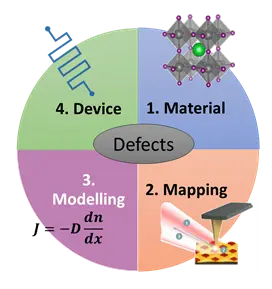Novel Semiconductor Devices
We are working on the device physics of various emerging semiconductor devices. Those include organic and perovskite solar cells and LEDs. Our focus is on the development of novel characterization techniques hand in hand with dedicated simulation approaches. The goal of our activities is to better understand performance limiting processes to enable better and more long-term stable devices. Currently, we are interested in the mixed ionic-electronic con-ductivity, which is a peculiarity of our perovskite semiconductors. Beyond collaborating with groups, who are specialized in the chemistry and device manufacturing, we fabricate our own solar cells and realize perovskite memristors.
Contributors: F. Ebadi, M. Mohammadi, H. Moumine, A. K. Sachan, M. Torre, O. Zbinden, W. Tress
Partner(s): EPFL, LMU, LiU
Funding: ERC Starting Grant
Duration: 2020–2025

Metal halide perovskites are fascinating semiconductors, which have seen just ten years of research for applications in solar cells and LEDs. During this time, power-conversion efficiencies of solar cells have been achieved that are comparable to established solar cell technologies. Driven by simple and low-energy fabrication processes, start-up and established companies are working on a commercialization of perovskite solar cells. However, operational stability is still a challenge, which can be partially tackled by encapsulation technologies. On the other hand, the instabilities are related to more perovskite-intrinsic properties such as mobile ionic lattice defects, which move under operation and influence the electric field in the device.
In this project, we intend to better characterize, model, control, and exploit such defects. We fabricate devices under test such as perovskite solar cells in a glovebox environment. For characterization we use optoelectronic measurements such as current-voltage curves and impedance spectroscopy as a function of light intensity and temperature. In an optical setup, we perform photo- and electroluminescence measurements on thin films and complete devices. Beyond those macroscopic measurements, we are developing measurements on the nanoscale, which are based on tip-enhanced spectroscopy. Modelling is employed to reproduce the data of those experiments. Here, we use available drift-diffusion simulations as implemented in setfos from Fluxim. Additionally, also in the framework of the DIZH, we want to explore, how machine learning approaches can complement our physics-based models.
Guided by our simulations, we will design and fabricate memristive devices that are supposed to be candidates for future neuromorphic computing. In contrast to the solar cells, these novel devices are in the state of basic research.
At the present state, we are characterizing solar cell samples from partners at EPFL. Our goal is to better understand the effects of surface treatments, which are employed to decrease performance losses due to defects and to enhance the long-term stability. Beyond stability, perovskite solar cells face another issue, which is the toxicity of the used element lead. Here, we collaborate with chemists at the LMU in Munich. They are developing alternative perovskite materials, where the lead cation is replaced by other metal cations, forming so-called double perovskites. However, these devices show a power-conversion efficiency of only few percent. Using voltage-dependent spectral response measurements, we were able to identify that one major loss mechanism is at the contacts, which are not charge-selective. This means that under high voltages both, negative and positive, charge carriers are collected at the same contact, which leads to currents that compensate each other and reduces the output power.